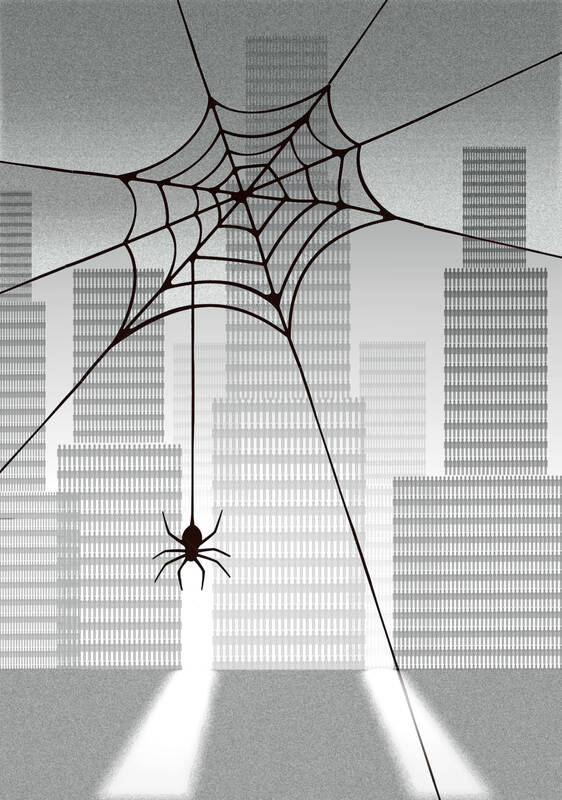Tokyo was once the symbol of the future, but now its government districts are drab, gray and falling behind
By Gearoid Reidy
/ Bloomberg Opinion
From Lost in Translation to the Japanese-inspired aesthetics of Blade Runner, Tokyo’s image overseas has long been one of skyscrapers jutting into the sky.
However, it is easy to forget that it was only recently that the capital developed vertically. In September 1964, ahead of the Tokyo Olympic Games, US skylines had long been dominated by decades-old landmarks such as the Empire State and Chrysler buildings. Meanwhile, the tallest structure in Tokyo was the nine-story National Diet Building, erected in 1936 after a 55-year design period.
Until the 1960s, Japan had strict prohibitions on developments higher than 31m, a provision that kept cities dense, but low. It was not until 1968 that the first skyscraper was even constructed, the 36-floor Kasumigaseki Building. The structure, which still stands today, was seen as a symbol of the “city of the future,” as postwar Tokyo sought to brand itself.

Illustration: Mountain People
For more than 150 years, Kasumigaseki and neighboring Nagata-cho have been the seat of political power in the country. They were chosen to house government buildings due to their proximity to the Imperial Palace, following the Meiji Restoration in 1868 that reinstated the Japanese Emperor’s rule. In subsequent years, the sites of many former samurai residences were redeveloped to house ministries and their staff.
If Kasumigaseki was once the symbol of the future, the area now feels stuck in the past. Many of the ministry offices are drab low-rises thrown up in the post-World War II era that prioritized resistance to natural disasters above aesthetics. Compounding the matter are nearby developments that have erected a line of glass skyscrapers casting a shadow on the district, literally and figuratively. At a time when many areas of Tokyo are getting rebuilt, it is time for a rethink.
To the east, the financial area of Otemachi and Marunouchi has been gradually built up into one of the world’s most striking central business districts. The transformation, spearheaded by Mitsubishi Estate Co, has seen dozens of structures rebuilt since 1998. Even newer properties, such as the Mitsubishi UFJ Financial Group Inc headquarters built in 1980, are already being demolished and reconstructed to keep pace, while the Hibiya business district is also changing.
More recently to the south, the once-poky Toranomon has been reimagined as a glistening commercial center. In April, Mori Building Co finally completed Toranomon Hills, a decades-long project of interconnected modern skyscrapers. A neighborhood once littered with stubby postwar architecture now boasts gleaming office blocks, luxury hotels and upmarket dining.
Meanwhile, Kasumigaseki and Nagata-cho look much the same as they did two or even three decades ago. That is due in part to proposals to relocate government functions outside of Tokyo that have consistently fallen through and the sunk cost of earthquake refittings following the 1995 Kobe disaster. The properties typically look exactly as you would expect from names such as “Central Government Building No. 1,” which houses the agriculture ministry and dates back to 1954. One official document accurately describes it as having “no particular decorative touches added.” This functional design dominates the area, while some of the oldest buildings (such as the neo-baroque old Ministry of Justice) or the newest (most notably the Kantei that houses the Prime Minister’s Office, built in 2002) are the most striking.
I am usually in favor of any redevelopment in Tokyo. The constantly shifting landscape is one of the capital’s most appealing aspects, and the competition between different areas means everywhere has to up its game. However, when it comes to Kasumigaseki, this is not just a matter of aesthetics. As the home of the nation’s bureaucrats, the crucial gears in the machine that is the Japanese state, it needs to be an attractive area to work to retain the best talent. This is where the government is starting to struggle.
The central bureaucracy can often be a brutal place to work, with long hours, low pay and travel budgets so meager workers are reported to pay out of pocket for hotels. Nearly 15 percent of civil servants under 30 are thinking of quitting, and despite the difficulty of passing the exams, a record number now leave within just 10 years. It is ironic that the public servants who in many cases draft the same laws that help improve the capital’s quality of life often find themselves in drab offices with little sunlight. Looking over to the sleek glass towers where their classmates who opted for the private sector work in sleek glass towers, they are entitled to have second thoughts.
However, the government seems unlikely to sponsor a multibillion-dollar spending spree to redo Kasumigaseki. The electorate tends to loathe money being spent on public servants, especially when the price of staples like rice are surging.
Perhaps this all just reflects the inevitable shifting of power from central government to business. However, a decline in quality in the civil service is something to be wary of. Japan, too, should avoid creating a world in which the private sector is the only place for talent to go.
Gearoid Reidy is a Bloomberg Opinion columnist covering Japan and the Koreas. He previously led the breaking news team in North Asia, and was the Tokyo deputy bureau chief. This column reflects the personal views of the author and does not necessarily reflect the opinion of the editorial board or Bloomberg LP and its owners.

AloJapan.com